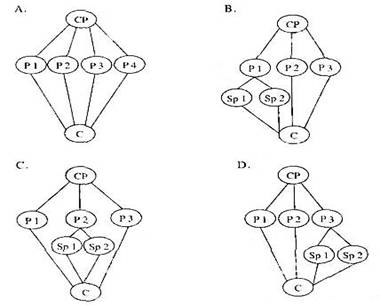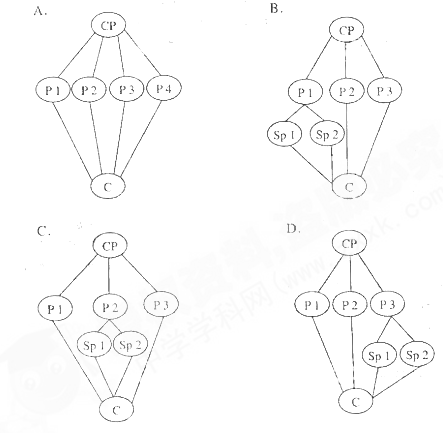-
Senses That Work Together
When we think about how our senses work, we usually imagine them operating separately: you sniff a flower, and the smell is delivered uninterrupted from nose to brain. However, it’ s more complex than that. Most evidence for cross-modal perception (知觉) comes from studies into sound and vision (视觉).
But research that shows other senses crossing over is coming out all the time, and it seems that even sound and smell sometimes form an unlikely pairing.
When New York researchers, Daniel Wesson and Donald Wilson, tried to find out the truth about a “ mysterious” area of the brain called the olfactory tubercle, they had to deal with this fact. Originally,they only intended to measure how olfactory tubercle cells in mice responded to smell. But during testing,
Wesson noticed that every time he put his coffee cup down, the mouse cells jumped in activity. In fact,the olfactory tubercle is well-placed to receive both smell and sound information from the outside world.
Later they found that among separate cells, most responded to a smell but a significant number were also active when a sound was made. Some cells even behaved differently when smell and sound were presented together, by increasing or decreasing their activity.
Of course, mice aren’ t people, so research team has been carrying out further experiments. They pulled together a group of people and gave them various drinks to smell. Participants were asked to sniff the drinks, and then match them to appropriate musical instruments and produce the notes at different levels. The results were interesting: piano was regularly paired with fruity fragrances; strong smells sounded like the instruments that are made of metal.
Further research found that listening to different sounds can change your perceptions. Studying taste this time, the team ordered some special toffee (太妃糖) and put together “ soundscapes” corresponding to bitterness and sweetness. Participants tasted similar pieces of toffee while listening to each soundscape, and found the toffee more bitter or sweeter, depending on which soundtrack they were listening to.
Studies like this are helping scientists correctly describe our understanding of the senses, and how the brain combines them with its advantage. The consequences are worth considering. Could we see musicians work together with chefs to produce sound-improved food and drink? Will you be ordering a coffee with a soundtrack to bring out your favorite smell? Come to think of it, that could be one thing you hope coffee shop chains don’ t get round to.
1.What does the underlined part in Paragraph 2 refer to?
A. A lot of research focuses on the senses.
B. Sound and vision are relatively easy to study.
C. There can be a link between sound and smell.
D. Evidence about the way senses work is hard to obtain.
2.In Wesson and Wilson’ s research, ______.
A. the mice were affected more significantly by sound
B. the result confirmed what the researchers had suspected
C. the mice seemed to be afraid of certain sounds or smells
D. the connection between sound and smell was found by chance
3.What is the main idea of Paragraph 3?
A. Participants took an active part in the experiments.
B. The purpose of the further experiments was totally different.
C. The result failed to support what was found in previous experiments.
D. Experiments showed that links between sound and smell were consistent.
4.How does the author feel about the effect of the research?
A. She is excited about the creative chances.
B. She is surprised at the recent developments.
C. She is convinced that the findings will be used soon.
D. She is worried about how the knowledge can be applied.
高三英语阅读理解中等难度题查看答案及解析
-
Everyone talks about the “five” senses of man.And it is true that we get our information about the outside from our sense of sight,hearing,smell,touch and taste.Researchers tell us that the sense of sight—our visual sense—gives us up to 80% of what we know about the world outside our bodies; while the other senses,the auditory (hearing),the olfactory (smell),the tactile (touch),and the gustatory (taste) bring into our brains information about the other 20% of what is happening.But there are two other senses that we cannot get along without,though they are little noticed.These are the senses of balance (平衡),without which we would act like a drunk after a heavy drink,and the kinesthetic sense(动觉),which gives us our ideas about our own motion (运动).
1.Which is the best title for this passage?
A. The Five Senses of Man
B. The Senses of Man
C. Senses and Information
D. Important Senses
2.The sense of sight supplies us with .
A. about half of our information about the world
B. about 20% of our information about the world
C. 80% of our information about the world
D. all the needed our information about the world
3.The senses of hearing,smell,touch and taste supply us with .
A. about half of our information about the world
B. about 20% of our information about the world
C. about 80% of our information about the world
D. all the needed our information about the world
4.According to the passage,one misses most about the world when one .
A. is blind
B. is deaf
C. has no sense of taste and touch
D. has no sense of balance and motion
高三英语阅读理解中等难度题查看答案及解析
-
We tend to have a better memory for things that excite our senses or our emotions than for straight facts.
A. block off. B. appeal to
C. subscribe to D. come across
高三英语单项填空中等难度题查看答案及解析
-
We tend to have a better memory for things that excite our senses or our emotions than for straight facts.
A. block off. B. appeal to
C. subscribe to D. come across
高三英语单项填空中等难度题查看答案及解析
-
We laugh at jokes,but seldom about how they work.
A.we think B.think we C.we do think D.do we think
高三英语单项填空简单题查看答案及解析
-
We laugh at jokes,but seldom________about how they work.
A.we think B.think we
C.we do think D.do we think
高三英语单项填空中等难度题查看答案及解析
-
We laugh at jokes,but seldom____________about how they work.
A.we think B.think we C.we do think D.do we think
高三英语单项填空简单题查看答案及解析
-
t is not how much we do but how much love we put into ____we do____benefits our work most.
A. That , who B. Which, that C. What , that D. What, what
高三英语单项填空中等难度题查看答案及解析
-
How Room Designs Affect Our Work and Feelings
Architects have long had the feeling that the places we live in can affect our thoughts, feelings and behaviors. But now scientists are giving this feeling an empirical(经验的,实证的) basis. They are discovering how to design spaces that promote creativity, keep people focused and lead to relaxation.
Researches show that aspects of the physical environment can influence creativity. In 2007, Joan Meyers-Levy at the University of Minnesota, reported that the height of a room's ceiling affects how people think. Her research indicates that higher ceilings encourage people to think more freely, which may lead them to make more abstract connections. Low ceilings, on the other hand, may inspire a more detailed outlook.
In additions to ceiling height, the view afforded by a building may influence an occupant's ability to concentrate. Nancy Wells and her colleagues at Cornell University found in their study that kids who experienced the greatest increase in greenness as a result of a family move made the most gains on a standard test of attention.
Using nature to improve focus of attention ought to pay off academically, and it seems to, according to a study led by C. Kenneth Tanner, head of the School Design & Planning Laboratory at the University of Georgia. Tanner and his team found that students in classrooms with unblocked views of at least 50 feet outside the window had higher scores on tests of vocabulary, language arts and maths than did students whose classrooms primarily overlooked roads and parking lots.
Recent study on room lighting design suggests than dim(暗淡的) light helps people to loosen up. If that is true generally, keeping the light low during dinner or at parties could increase relaxation. Researchers of Harvard Medical School also discovered that furniture with rounded edges could help visitors relax.
So far scientists have focused mainly on public buildings. "We have a very limited number of studies, so we're almost looking at the problem through a straw(吸管)," architect David Allison says. "How do you take answers to very specific questions and make broad, generalized use of them? That's what we're all struggling with."
1.What does Joan Meyers-Levy focus on in her research?
A. Light. B. Ceilings. C. Windows. D. Furniture.
2.The passage tells us that ______.
A. the shape of furniture may affect people's feelings
B. lower ceilings may help improve students' creativity
C. children in a dim classroom may improve their grades
D. students in rooms with unblocked views may feel relaxed
3.The underlined sentence in the last paragraph probably means that ______.
A. the problem is not approached step by step
B. the researches so far have faults in themselves
C. the problem is too difficult for researchers to detect
D. research in this area is not enough to make generalized patterns
4.Which of the following shows the organization of the passage?

CP: Central Point P: Point SP: Sub-point(次要点) C: Conclusion高三英语阅读理解困难题查看答案及解析
-
How Room Designs Affect Our Work and Feeling
Architects have long had the feeling that the place we live in can affect our thoughts, feeling and behaviors. But now scientists are giving this feeling an empirical(经验的,实证的)basis. They are discovering how to design spaces that promote creativity, keep people focused, and lead to relaxation.
Researches show that aspects of the physical environment can influence creativity. In 2009, Joan Meyers-Levy at the University of Minnesota, reported that the height of a room’s ceiling affects how people think. Her research indicates that higher ceilings encourage people to think more freely, which may lead them to make more abstract connections. Low ceilings, on the other hand, may inspire a more detailed outlook.
In addition to ceiling height, the view afforded by a building may influence an occupant’s ability to concentrate. Nancy Wells and her colleagues at Cornell University result of a family move made the most gains on a standard test of attention.
Using nature to improve focus of attention ought to pay off academically, and it seems to, according to a study led by C. Kenneth Tanner, head of the School Design & Planning Laboratory at the University of Georgia. Tanner and his team found that higher scores on tests of vocabulary, language arts and maths than did students whose classrooms primarily overlooked roads and parking lots.
Recent study on room lighting design suggests that dim(暗淡的)light helps people to loosen up. If that is true generally, keeping the light low during dinner, or at parties could increase relaxation. Researchers of Harvard Medical School also discovered that furniture with rounded edges could help visitors relax.
So far scientists have focused mainly on public buildings. “We have a very limited number of studies, so we are almost looking at the problem through a straw(吸管)” architect David Allison says; “How do you take answers to very specific questions and make broad ,generalize use of them?” That is what we are all struggling with”
57. What does Joan Meyers-Levy focus on in her research?
A. Light B. Ceilings. C. Windows. D. Furniture
58.The passage tells us that____________.
A.the shape of furniture may affect people’s feelings
B.lower ceilings may help improve students’creativity
C.children in a dim classroom may improve their grades
D.students in rooms with unblocked views may feel relaxed
59.The underlined sentence in the last paragraph probably mean that_______.
A.the problem is not approached step by step
B.the researches so far have faults in themselves
C.the problem is too difficult for researchers to detect
D.research in this area is not enough to make generalized pattems
60.Which of the following shows the organization of the passage?

CP :Central Point P:point SP:: Sub-point(次要点) C:Conclusion
高三英语阅读理解简单题查看答案及解析